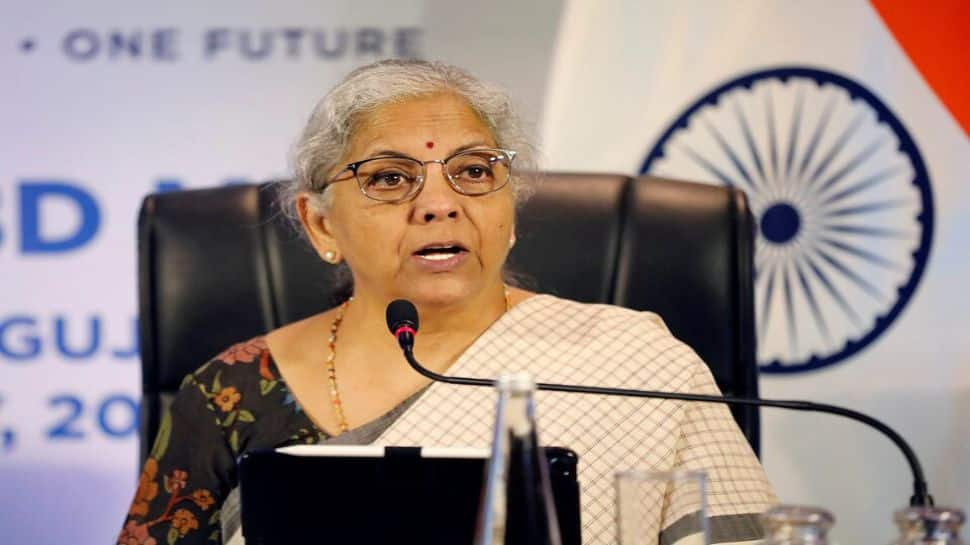Business
Stock market outlook: How will Nifty50, BSE Sensex react to US Fed chair Powell’s rate cut hints? What analysts say – Times of India

Indian equity benchmark indices, Nifty50 and BSE Sensex, are expected to see a gap-up opening on Monday after US Federal Reserve chairman Jerome Powell indicated that the central bank may cut rates in its September policy review.Analysts suggest that domestic equity markets may respond positively to signals of a possible US Federal Reserve rate reduction, whilst investors remain watchful of the approaching deadline for supplementary US tariffs on Indian products in the upcoming shortened trading week. Favourable international indicators may offer backing, following substantial gains in US markets and weakening of the dollar index after Powell signalled possible rate reductions during his Jackson Hole Symposium address, analysts say.Additionally, market movements during the week will be influenced by foreign investor activities, international market developments and scheduled economic data releases such as GDP growth numbers.Last week witnessed the BSE benchmark advancing by 709.19 points or 0.87%, whilst the Nifty registered gains of 238.8 points or 0.96%.
What Fed’s Powell indicated on rate cut
Jerome Powell suggested on Friday that interest rates might be reduced during the September central bank meeting. He adopted a careful approach, avoiding definite promises about rate cuts. His statement recognised growing worries about jobs whilst noting ongoing inflation concerns.“While the labor market appears to be in balance, it is a curious kind of balance that results from a marked slowing in both the supply of and demand for workers. This unusual situation suggests that downside risks to employment are rising, and if those risks materialize, they can do so quickly in the form of sharply higher layoffs and rising unemployment,” Powell said.“At the same time, GDP growth has slowed, notably in the first half of this year, to a pace of 1.2%, roughly half the 2.5% pace in 2024. The decline in growth has largely reflected a slowdown in consumer spending, as with the labor market. Some of the slowing in GDP likely reflects slower growth of supply or potential output.“We continue to believe that monetary policy must be forward looking and consider the lags its effects on the economy. For this reason, our policy actions depend on the economic outlook and the balance of risks to that outlook,” he said.
How will Indian stock markets react?
According to Sunny Agrawal, Head – Fundamental Research at SBI Securities, Indian stock markets are expected to react positively on Monday. “Powell indicates conditions ‘may warrant’ interest rate cuts as the situation suggests downside risks to employment rising. This is likely to put pressure on the dollar and augur well for riskier asset classes – EMs like India and commodities. Metals and IT stocks are likely to react positively in the trade on Monday,” Agarwal told TOI.Dr VK Vijayakumar, Chief Investment Strategist, Geojit Investments Limited said the stock market’s upside may be muted to US President Donald Trump’s lingering tariffs.“Fed chief Powell’s speech at Jackson Hole indicates a rate cut in September. His remark that ‘there is a downside risk to unemployment and shifting risk balance may warrant policy adjustment’ clearly indicates a rate cut in September. The US markets have responded with rise in stock prices and decline in bond yields. The Indian market, too, may respond positively on Monday, but here tariff concerns are likely to weigh on markets more,” he told TOI.Siddhartha Khemka, who leads Research at the Wealth Management division of Motilal Oswal Financial Services Ltd, said, “We expect Indian equities to remain supported by optimism around GST 2.0 reforms and domestic macro strength. Globally, clarity on US tariff actions against India and upcoming GDP data from both India and the US will shape investor sentiment”.(Disclaimer: Recommendations and views on the stock market and other asset classes given by experts are their own. These opinions do not represent the views of The Times of India)
Business
India’s $5 Trillion Economy Push Explained: Why Modi Govt Wants To Merge 12 Banks Into 4 Mega ‘World-Class’ Lending Giants

India’s Public Sector Banks Merger: The Centre is mulling over consolidating public-sector banks, and officials involved in the process say the long-term plan could eventually bring down the number of state-owned lenders from 12 to possibly just 4. The goal is to build a banking system that is large enough in scale, has deeper capital strength and is prepared to meet the credit needs of a fast-growing economy.
The minister explained that bigger banks are better equipped to support large-scale lending and long-term projects. “The country’s economy is moving rapidly toward the $5 trillion mark. The government is active in building bigger banks that can meet rising requirements,” she said.
Why India Wants Larger Banks
Sitharaman recently confirmed that the government and the Reserve Bank of India have already begun detailed conversations on another round of mergers. She said the focus is on creating “world-class” banks that can support India’s expanding industries, rising infrastructure investments and overall credit demand.
She clarified that this is not only about merging institutions. The government and RBI are working on strengthening the entire banking ecosystem so that banks grow naturally and operate in a stable environment.
According to her, the core aim is to build stronger, more efficient and globally competitive banks that can help sustain India’s growth momentum.
At present, the country has a total of 12 public sector banks: the State Bank of India (SBI), the Punjab National Bank (PNB), the Bank of Baroda, the Canara Bank, the Union Bank of India, the Bank of India, the Indian Bank, the Central Bank of India, the Indian Overseas Bank (IOB) and the UCO Bank.
What Happens To Employees After Merger?
Whenever bank mergers are discussed, employees become anxious. A merger does not only combine balance sheets; it also brings together different work cultures, internal systems and employee expectations.
In the 1990s and early 2000s, several mergers caused discomfort among staff, including dissatisfaction over new roles, delayed promotions and uncertainty about reporting structures. Some officers who were promoted before mergers found their seniority diluted afterward, which created further frustration.
The finance minister addressed the concerns, saying that the government and the RBI are working together on the merger plan. She stressed that earlier rounds of consolidation had been successful. She added that the country now needs large, global-quality banks “where every customer issue can be resolved”. The focus, she said, is firmly on building world-class institutions.
‘No Layoffs, No Branch Closures’
She made one point unambiguous: no employee will lose their job due to the upcoming merger phase. She said that mergers are part of a natural process of strengthening banks, and this will not affect job security.
She also assured that no branches will be closed and no bank will be shut down as part of the consolidation exercise.
India last carried out a major consolidation drive in 2019-20, reducing the number of public-sector banks from 21 to 12. That round improved the financial health of many lenders.
With the government preparing for the next phase, the goal is clear. India wants large and reliable banks that can support a rapidly growing economy and meet the needs of a country expanding faster than ever.
Business
Stock market holidays in December: When will NSE, BSE remain closed? Check details – The Times of India

Stock market holidays for December: As November comes to a close and the final month of the year begins, investors will want to know on which days trading sessions will be there and on which days stock markets are closed. are likely keeping a close eye on year-end portfolio adjustments, global cues, and corporate earnings.For this year, the only major, away from normal scheduled market holidays in December is Christmas, observed on Thursday, December 25. On this day, Indian stock markets, including the Bombay Stock Exchange (BSE) and National Stock Exchange (NSE), will remain closed across equity, derivatives, and securities lending and borrowing (SLB) segments. Trading in currency and interest rate derivatives segments will continue as usual.Markets are expected to reopen on Friday, December 26, as investors return to monitor global developments and finalize year-end positioning. Apart from weekends, Christmas is the only scheduled market holiday this month, making December relatively quiet compared with other festive months, with regards to stock markets.The last trading session in November, which was November 28 (next two days being the weekend) ended flat. BSE Sensex slipped 13.71 points, or 0.02 per cent, to settle at 85,706.67, after hitting an intra-day high of 85,969.89 and a low of 85,577.82, a swing of 392.07 points. Meanwhile, the NSE Nifty fell 12.60 points, or 0.05 per cent, to 26,202.95, halting its two-day rally.
Business
North Tyneside GP says debt stress causing mental health issues

A GP says patients are presenting with mental health problems because of stress they feel over their levels of personal debt.
According to Citizens Advice, north-east England has the second highest number of people who require professional assistance with debt problems – only London is higher.
Debt charity StepChange said in 2024 the highest concentration of their clients were in the North East, with 37 clients per 10,000 adults.
Dr Kamlesh Sreekissoon, who works as a GP in North Tyneside, said people were juggling “three or four jobs” in the build up to Christmas in order to manage and subsequently struggling with their mental health.
The most common reason for personal debt as reported by Stepchange’s North East clients is a rise in the cost of living (19.3%) and a lack of control over finances (19%).
Both these statistics outstrip the UK figures of 17.7% and 17.9% respectively.
Citizens Advice said thousands of people were falling deeper into debt to meet the cost of basic essentials such as food and fuel, rather than luxuries, but that people also felt under pressure to provide for Christmas.
Dr Sreekissoon said the stress caused by the debt people faced was compounded by issues relating to their family situations.
“At this time of year you will see people juggling three or four jobs, also after caring for elderly relatives, parents, [they’re] stressed out and unfortunately struggling with their mental health,” said Dr Sreekissoon.
He said the debt his patients described was not caused by buying unnecessary things, but by simply struggling to make ends meet.
“It’s more the basics,” he said. “I see people taking on working long hours, doing two or three jobs, and just being kind of stretched out, not being able to see their kids, and that just burns people out which is really sad to see”.
-

 Sports7 days ago
Sports7 days agoWATCH: Ronaldo scores spectacular bicycle kick
-

 Entertainment7 days ago
Entertainment7 days agoWelcome to Derry’ episode 5 delivers shocking twist
-

 Politics7 days ago
Politics7 days agoWashington and Kyiv Stress Any Peace Deal Must Fully Respect Ukraine’s Sovereignty
-

 Business7 days ago
Business7 days agoKey economic data and trends that will shape Rachel Reeves’ Budget
-

 Tech5 days ago
Tech5 days agoWake Up—the Best Black Friday Mattress Sales Are Here
-

 Fashion7 days ago
Fashion7 days agoCanada’s Lululemon unveils team Canada kit for Milano Cortina 2026
-

 Tech5 days ago
Tech5 days agoThe Alienware Aurora Gaming Desktop Punches Above Its Weight
-

 Politics7 days ago
Politics7 days ago53,000 Sikhs vote in Ottawa Khalistan Referendum amid Carney-Modi trade talks scrutiny












